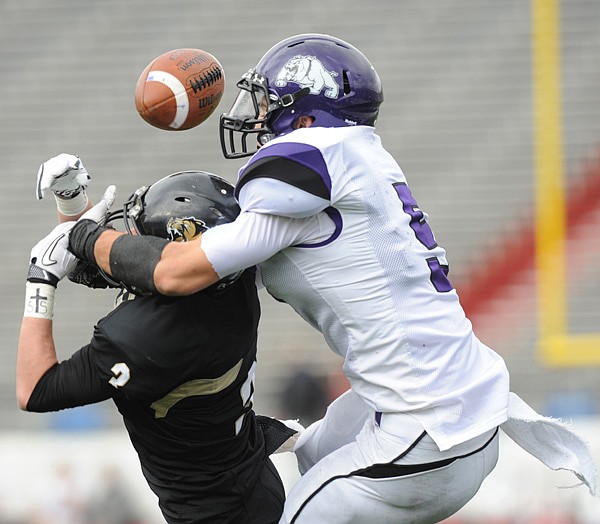Tigers Must Adjust To Stadium’s Size, Sounds
Bentonville’s Chris Mizelle, left, and Fayetteville’s Alex Brignoni reach for a pass during last year’s Class 7A state championship game in War Memorial Stadium in Little Rock. The players return to the title game Saturday.
Wednesday, November 28, 2012
BENTONVILLE — John Donald was in awe of War Memorial Stadium when he stepped onto the field before last year’s Class 7A State Championship football game.
The noise that was being made once the game started may have made a more lasting impression on Bentonville’s inside linebacker.
Saturday’s Ticket
Bentonville vs. Fayetteville
KICKOFF: 6:30 p.m. Saturday
WHERE: War Memorial Stadium, Little Rock
RECORDS: Bentonville 12-0; Fayetteville 9-3
HOOTEN’S RANKING: Bentonville is No. 1 in Class 7A; Fayetteville is No. 2.
HOOTEN’S LINE: Fayetteville by 1.
“You walk out there and you see how big it is,” Donald said. “Then it’s loud, with nowhere for the sound to go. Everybody’s yelling down at you, and it stays with you.
“It’s always a great atmosphere when we play in Little Rock. ”
The announced attendance for the Saturday afternoon meeting between Bentonville and Fayetteville was only 4,821 in the 54,120-seat stadium. The crowd — which ranks fourth in the six years a Class 7A title game has been played — couldn’t have filled Tiger Stadium to capacity and falls well short of the 7,568 fans who were there when the two Northwest Arkansas rivals played in the 2010 state championship.
War Memorial Stadium’s bowl-shaped structure, however, is something the Tigers don’t experience except during the championship games. It can make smaller crowds even louder, and the fans’ closeness to the sidelines can add to the noise level.
“A field is a field, and you go play,” Bentonville coach Barry Lunney said. “But that’s one reason why you go out and work out on it before the game. You go out and get your kids used to it.
“It can get loud because the sound vibrates off the walls. You feel the excitement of the game, and you can hear the fans, for sure, because the sidelines are pretty close. For a college stadium, that’s not much room between the sidelines and the first row of seats. The fans are pretty much on top of you.”
Lunney said the noise doesn’t play a significant role with play calls made by coaches on the sideline. Most of it is done with signs or hand signals, so communication isn’t hindered there.
The hardest part of communication may be between teammates, when they are trying to pass calls or signals to each other while they are on the field. It could mean the difference between a big play and a busted play.
“We try to use different ways to communicate to teammates,” Donald said. “Maybe not with sound, but with signs and stuff and make sure everybody is on the same page.
“We definitely have to communicate when people aren’t cheering, especially when we’re trying to correct something.”
The biggest difference that War Memorial Stadium provides is the narrower goal posts used during college games. It provides kickers with a bigger challenge, especially since the space between the hashmarks is wider on high school fields than on college fields.
Lunney has addressed it by having portable goal posts brought into Tiger Stadium for this week’s practices. He’s also brought it up about possible changes in past situations.
“If they have to kick a field goal at a college goal post, they should have to place the ball on college hashmarks,” Lunney said. “I haven’t got anywhere with it, but it would be my one appeal, at least for the kids’ sake.”
